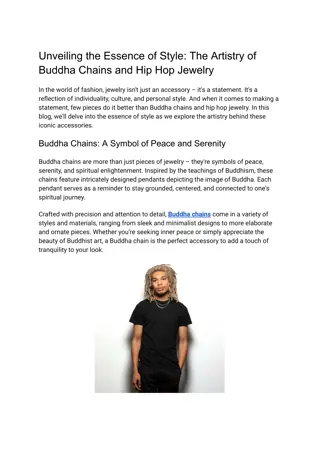Sprinting Event - Identifying Gold, Silver, and Bronze Medallists
In a sprinting event, the reaction time between the gun firing and athletes leaving the starting block is crucial. This task involves identifying the top three medallists based on their lane number, reaction time, and final time in a 100-meter sprint race. By analyzing the data of 8 runners provided in the table, we aim to determine the Gold, Silver, and Bronze medallists.
Download Presentation

Please find below an Image/Link to download the presentation.
The content on the website is provided AS IS for your information and personal use only. It may not be sold, licensed, or shared on other websites without obtaining consent from the author. Download presentation by click this link. If you encounter any issues during the download, it is possible that the publisher has removed the file from their server.
E N D
Presentation Transcript
Mathematics Unit 35: Reaction Time What do we want to find out? In a Sprinting event, the reaction time is the time interval between the starter s gun firing and the athlete leaving the starting block. The final time includes both this reaction time, and the running time. The following table gives the reaction time and the final time of 8 runners in a 100 metre sprint race. What do we want to find out? What useful information do we know? What useful information do we know? What other mathematical techniques do we need to apply? What other mathematical techniques do we need to apply? What have we learned? What have we learned? QUESTION 35.1 Identify the Gold, Silver and Bronze medallists from this race. Fill in the table below with the medallists lane number, reaction time and final time.
Mathematics Unit 35: Reaction Time What do we want to find out? In a Sprinting event, the reaction time is the time interval between the starter s gun firing and the athlete leaving the starting block. The final time includes both this reaction time, and the running time. The following table gives the reaction time and the final time of 8 runners in a 100 metre sprint race. What do we want to find out? What useful information do we know? What useful information do we know? What other mathematical techniques do we need to apply? What other mathematical techniques do we need to apply? What have we learned? What have we learned? QUESTION 35.1 Identify the Gold, Silver and Bronze medallists from this race. Fill in the table below with the medallists lane number, reaction time and final time. Back to start Back to start
Mathematics Unit 35: Reaction Time What do we want to find out? In a Sprinting event, the reaction time is the time interval between the starter s gun firing and the athlete leaving the starting block. The final time includes both this reaction time, and the running time. The following table gives the reaction time and the final time of 8 runners in a 100 metre sprint race. What do we want to find out? What useful information do we know? What useful information do we know? What other mathematical techniques do we need to apply? What other mathematical techniques do we need to apply? What have we learned? What have we learned? QUESTION 35.1 Identify the Gold, Silver and Bronze medallists from this race. Fill in the table below with the medallists lane number, reaction time and final time. Back to start Back to start
Mathematics Unit 35: Reaction Time What do we want to find out? In a Sprinting event, the reaction time is the time interval between the starter s gun firing and the athlete leaving the starting block. The final time includes both this reaction time, and the running time. The following table gives the reaction time and the final time of 8 runners in a 100 metre sprint race. What do we want to find out? What useful information do we know? What useful information do we know? What other mathematical techniques do we need to apply? What other mathematical techniques do we need to apply? What have we learned? What have we learned? QUESTION 35.1 Identify the Gold, Silver and Bronze medallists from this race. Fill in the table below with the medallists lane number, reaction time and final time. Back to start Back to start
Mathematics Unit 35: Reaction Time What do we want to find out? In a Sprinting event, the reaction time is the time interval between the starter s gun firing and the athlete leaving the starting block. The final time includes both this reaction time, and the running time. The following table gives the reaction time and the final time of 8 runners in a 100 metre sprint race. What do we want to find out? What useful information do we know? What useful information do we know? What other mathematical techniques do we need to apply? What other mathematical techniques do we need to apply? What have we learned? What have we learned? QUESTION 35.1 Identify the Gold, Silver and Bronze medallists from this race. Fill in the table below with the medallists lane number, reaction time and final time. Back to start Back to start
Mathematics Unit 35: Reaction Time What do we want to find out? What do we want to find out? What useful information do we know? What useful information do we know? What other mathematical techniques do we need to apply? What other mathematical techniques do we need to apply? QUESTION 35.2 To date, no humans have been able to react to a starter s gun in less than 0.110 second. If the recorded reaction time for a runner is less then 0.110 second, then a false start is considered to have occurred because the runner must have left before hearing the gun. What have we learned? What have we learned? If the Bronze medallist had a faster reaction time, would he have had a chance to win the Silver medal? Give an explanation to support your answer.
Mathematics Unit 35: Reaction Time What do we want to find out? What do we want to find out? What useful information do we know? What useful information do we know? What other mathematical techniques do we need to apply? What other mathematical techniques do we need to apply? QUESTION 35.2 To date, no humans have been able to react to a starter s gun in less than 0.110 second. If the recorded reaction time for a runner is less then 0.110 second, then a false start is considered to have occurred because the runner must have left before hearing the gun. What have we learned? What have we learned? If the Bronze medallist had a faster reaction time, would he have had a chance to win the Silver medal? Give an explanation to support your answer. Back to start Back to start
Mathematics Unit 35: Reaction Time What do we want to find out? What do we want to find out? What useful information do we know? What useful information do we know? What other mathematical techniques do we need to apply? What other mathematical techniques do we need to apply? QUESTION 35.2 To date, no humans have been able to react to a starter s gun in less than 0.110 second. If the recorded reaction time for a runner is less then 0.110 second, then a false start is considered to have occurred because the runner must have left before hearing the gun. What have we learned? What have we learned? If the Bronze medallist had a faster reaction time, would he have had a chance to win the Silver medal? Give an explanation to support your answer. Back to start Back to start
Mathematics Unit 35: Reaction Time What do we want to find out? What do we want to find out? What useful information do we know? What useful information do we know? What other mathematical techniques do we need to apply? What other mathematical techniques do we need to apply? QUESTION 35.2 To date, no humans have been able to react to a starter s gun in less than 0.110 second. If the recorded reaction time for a runner is less then 0.110 second, then a false start is considered to have occurred because the runner must have left before hearing the gun. What have we learned? What have we learned? If the Bronze medallist had a faster reaction time, would he have had a chance to win the Silver medal? Give an explanation to support your answer. Back to start Back to start
Mathematics Unit 35: Reaction Time What do we want to find out? What do we want to find out? What useful information do we know? What useful information do we know? What other mathematical techniques do we need to apply? What other mathematical techniques do we need to apply? QUESTION 35.2 To date, no humans have been able to react to a starter s gun in less than 0.110 second. If the recorded reaction time for a runner is less then 0.110 second, then a false start is considered to have occurred because the runner must have left before hearing the gun. What have we learned? What have we learned? If the Bronze medallist had a faster reaction time, would he have had a chance to win the Silver medal? Give an explanation to support your answer. Back to start Back to start























